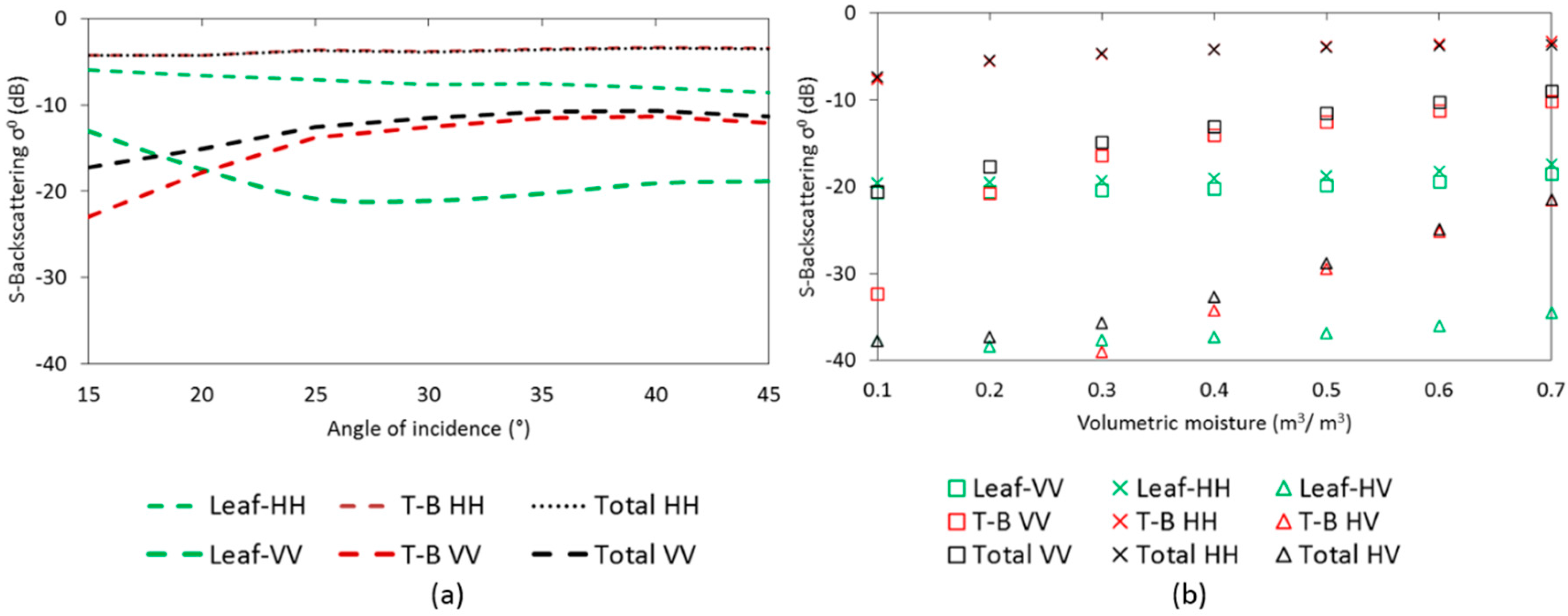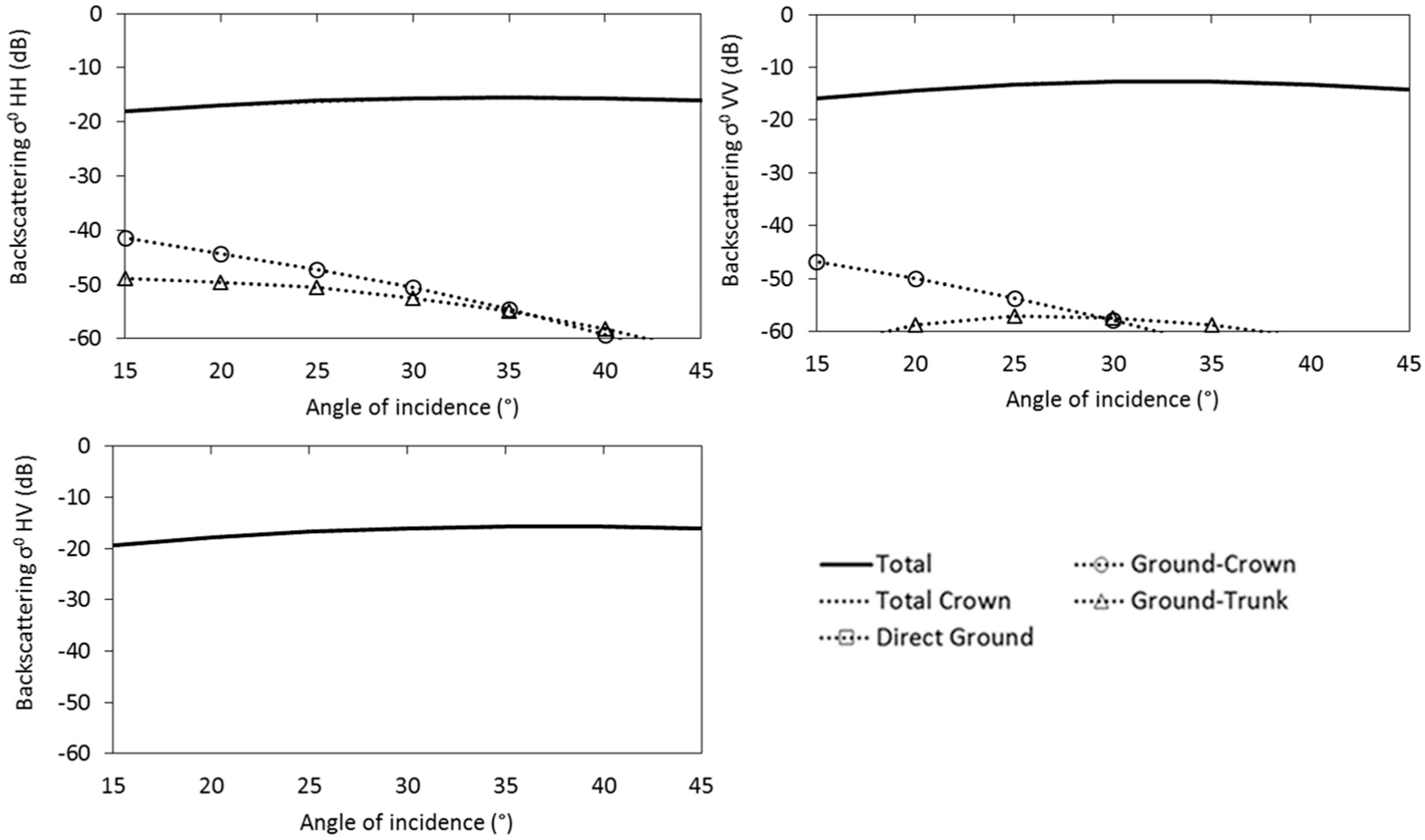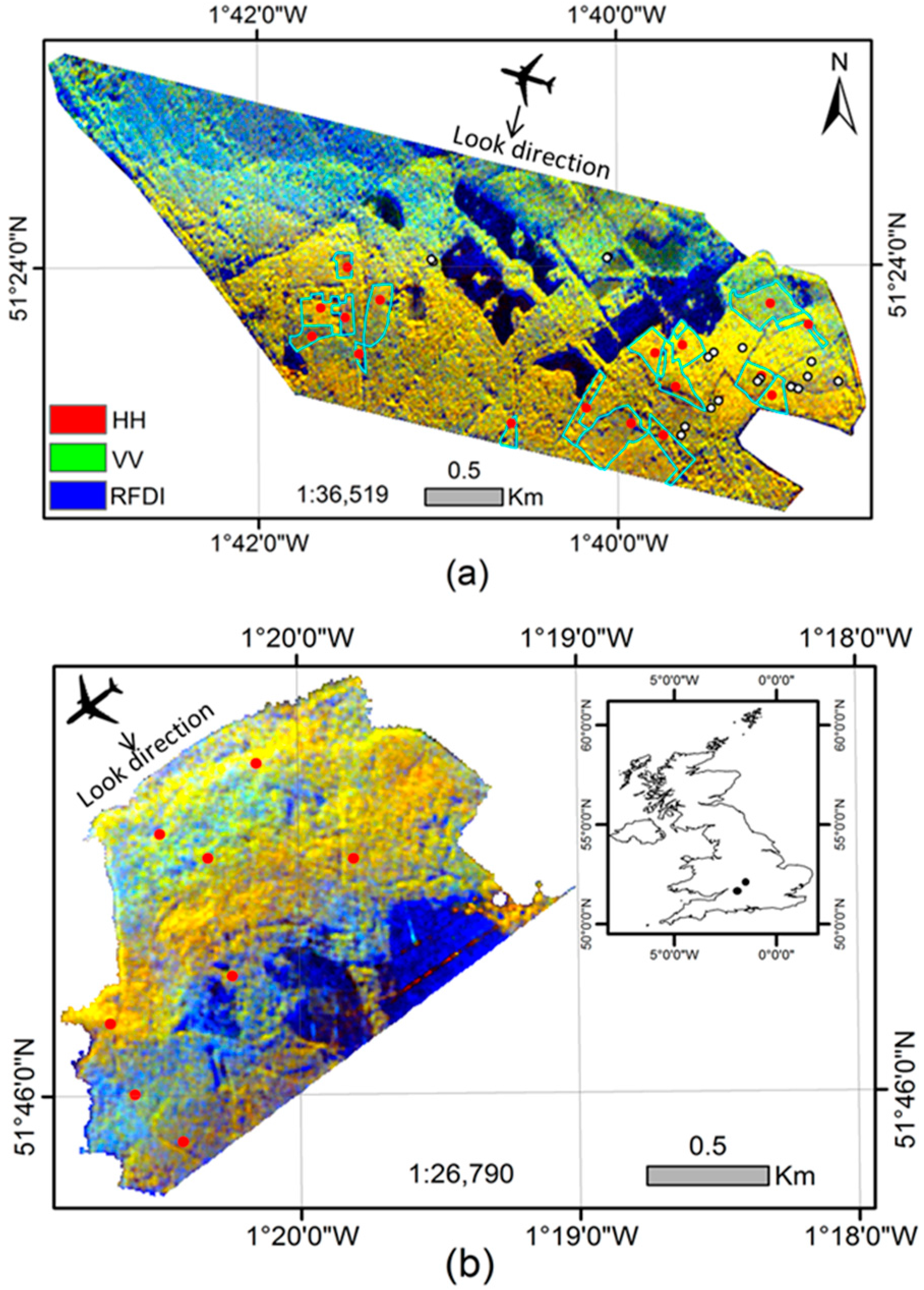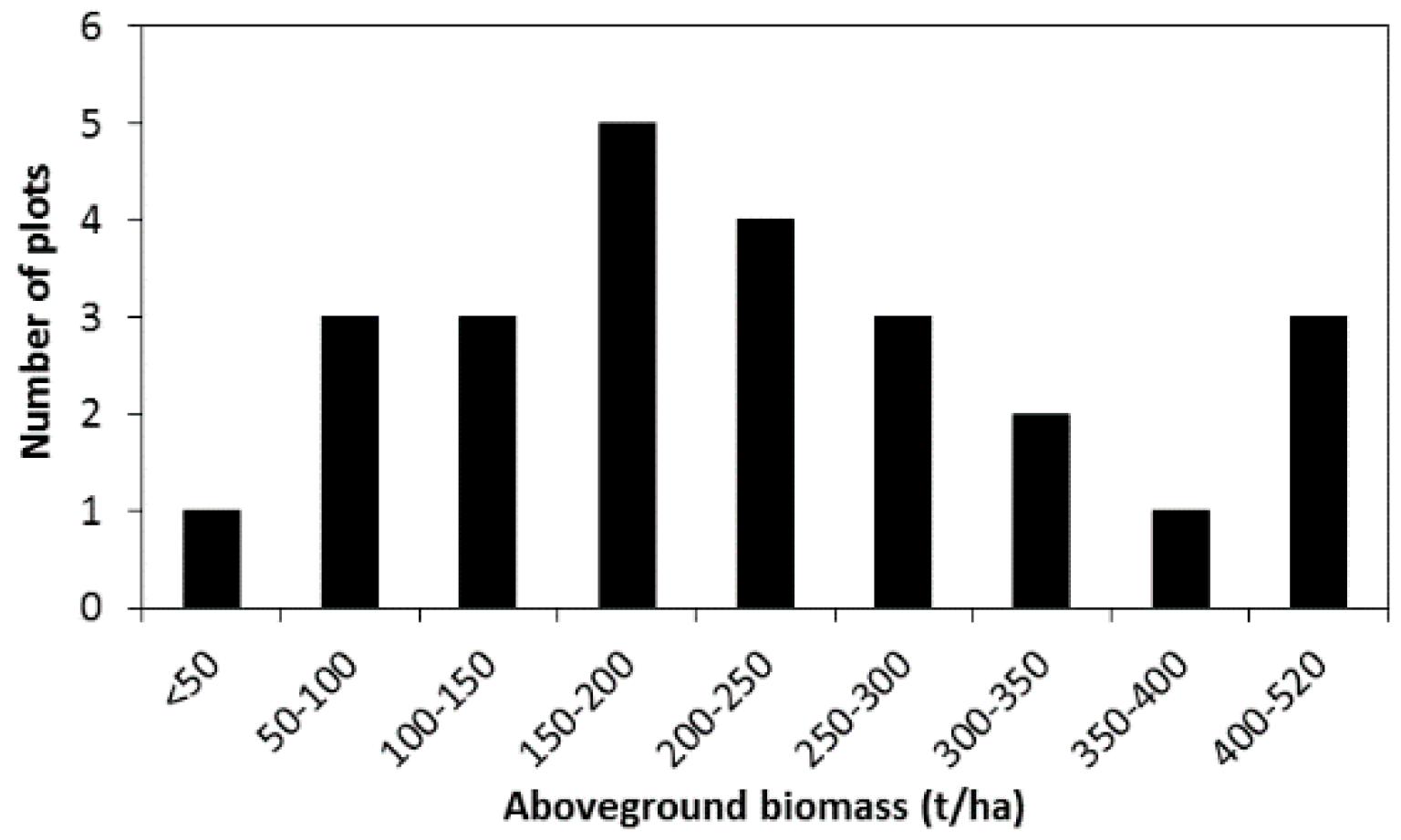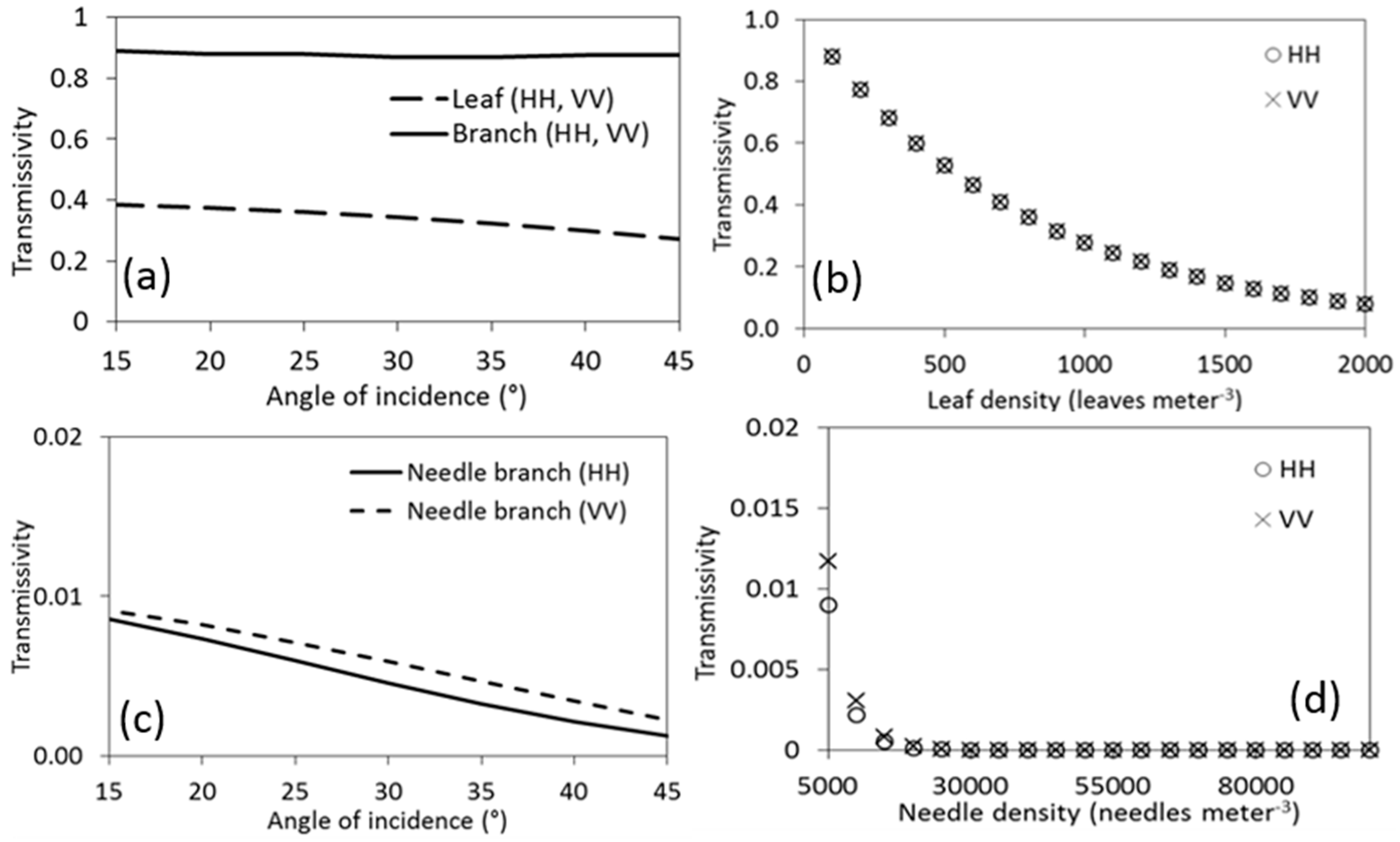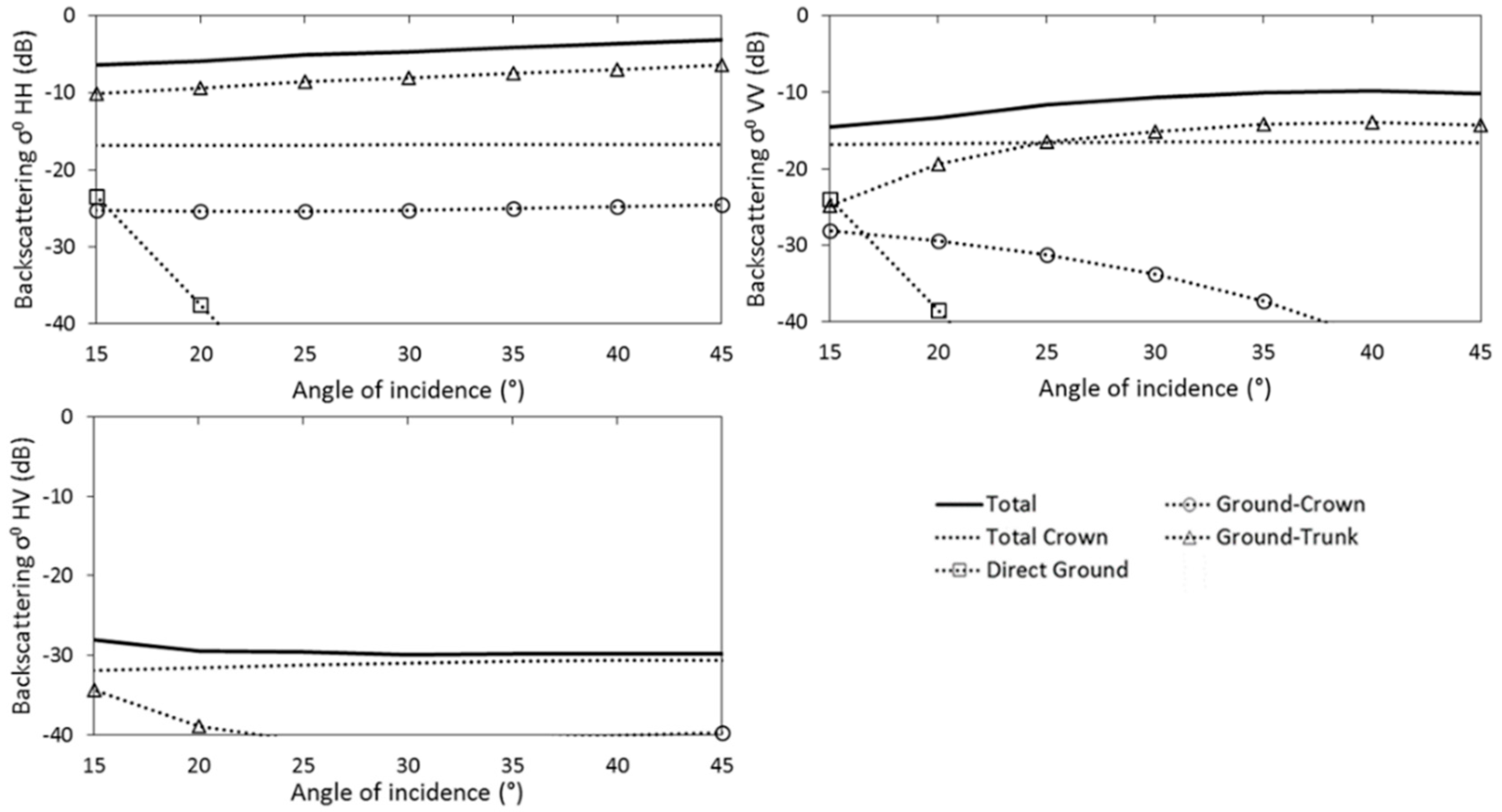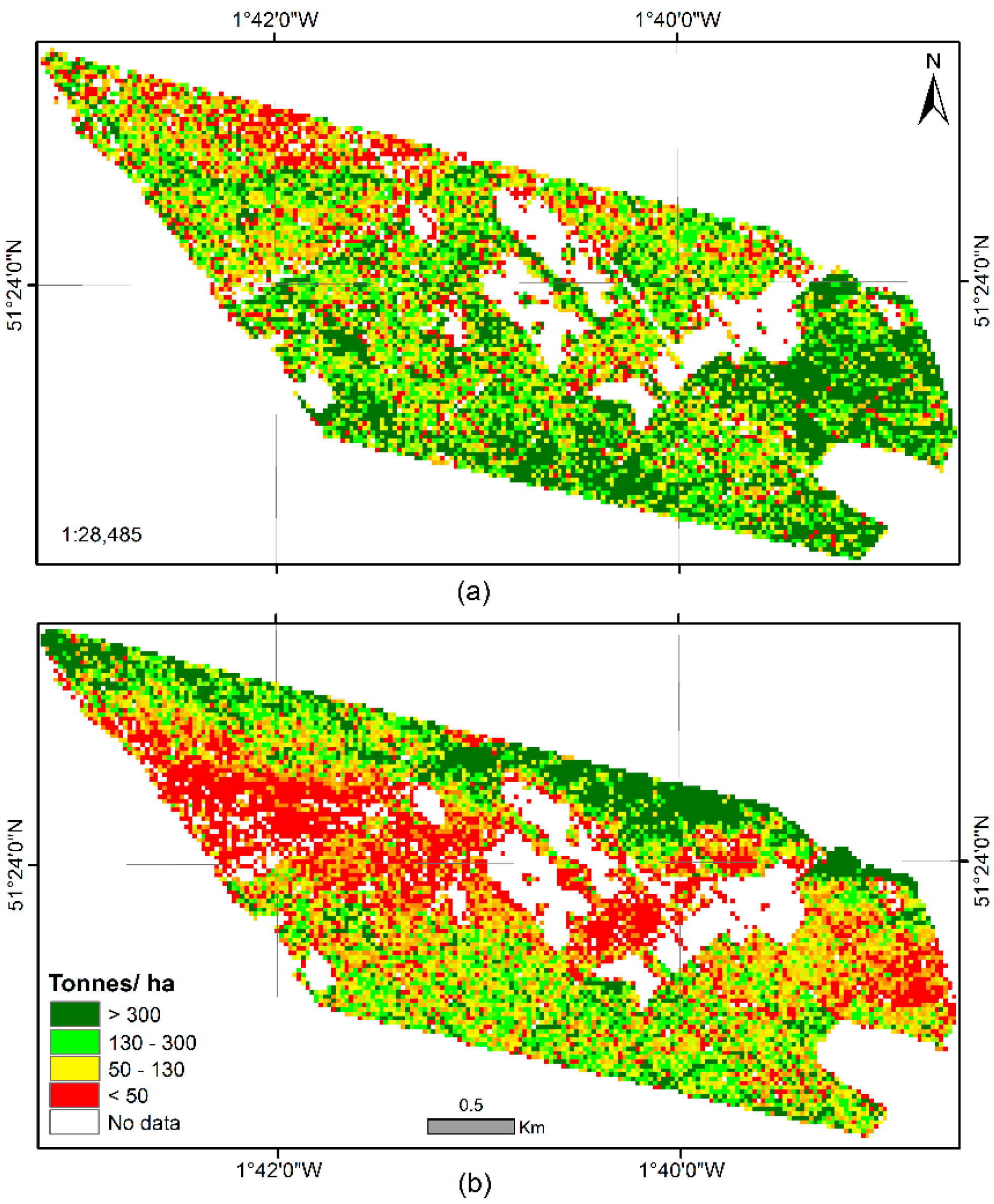1. Introduction
Forest is a living entity, capable of storing a large amount of carbon dioxide from the atmosphere. Terrestrial carbon is being stored in the form of aboveground biomass (AGB) as the trunk, branches and leaves of an individual tree, while forest AGB is the total biomass (living matter) of all growing trees per unit area. Quantification of forest AGB is essential to understand the spatial distribution of carbon in forests, particularly in old-growth forests [
1] and to derive prognostics for monitoring the carbon stock trends.
Forest AGB is estimated with sample plot measurements from forest inventories e.g., in the tropics [
2,
3] and in Europe [
4,
5]. This approach of biomass measurement has been regarded as highly accurate; however, it involves some uncertainty primarily due to the use of allometric models to derive the forest AGB rather than direct measurements. Additionally, tree-level AGB estimates involve errors when upscaled to plot or landscape scale [
6]. In the absence of large-scale inventory plots, most efforts for quantifying the distribution of biomass have focused on interpolation techniques at landscape or continental scale [
7]. Due to the nature of the sampling with low temporal repeat frequency and a small number of inventory plots, the use of Earth Observation (EO) data acquired by satellite sensors are often being combined with field measurements [
8,
9,
10]. For example, EO-based estimations have been shown to be similar to predictions derived from field estimates when averaging at large scales e.g., stand, landscape or even continental scale [
11]. However, differences between biomass estimates are being reported particularly in regions with few sampling sites [
12].
Wall-to-wall estimates of forest AGB derived from an integration of EO-data and field measurements across different biomes are available: tropical forest [
9,
10] and boreal forest [
13]. For a long time, optical data with 8 km resolution from the Advanced Very High Resolution Radiometer (AVHRR) have been utilized. For example, forest AGB has been quantified over decadal periods across six countries (Canada, Finland, Norway, Russia, Sweden and the USA) with temperate and boreal forests from global AVHRR-derived maximum normalized difference vegetation index (NDVI) datasets [
14,
15]. The average absolute difference between EO-derived and inventory estimates was 27%, 33%, and 50% of the mean inventory estimates of AGB, total AGB and changes in carbon pools respectively. With the launch of the Terra and Aqua satellites carrying MODerate resolution Imaging Spectrometer (MODIS) instruments with spatial resolution down to 250 m, the bidirectional reflectance distribution function (BRDF) is also useful for mapping AGB across forests of different structures in Russia [
16]. However, optical data are particularly sensitive to cloud cover, atmospheric aerosol loading and low solar illumination.
To overcome these limitations, advanced remote sensing technique of light detection and ranging (LiDAR) and microwave based Synthetic Aperture Radar (SAR) data are used. LiDAR data from the spaceborne Ice, Cloud and Land Elevation Satellite (ICESat) Geoscience Laser Altimeter System (GLAS) were utilized to estimate canopy height and estimates of AGB using empirically derived models that relate LiDAR variables to AGB using field plots with MODIS data [
9,
10]. The study by Saatchi, Harris, Brown, Lefsky, Mitchard, Salas, Zutta, Buermann, Lewis, Hagen, Petrova, White, Silman and Morel [
9] has also utilized microwave data from QuickSCAT. Therefore, microwave based SAR sensors have been extensively used for forest characterization, mapping and assessing forest biomass because of the sensitivity of radar signals to complex forest structure and its component parts (trunks, branches and leaves) [
17,
18]. SAR satellites provide continuous data that are largely independent of cloud cover and solar illumination condition.
The first L-band observations at global scale were provided by the Japanese Earth Resources Satellite (JERS-1) SAR (1992–1998), while the Russian Almaz-1 (1991–1992) provided S-band and the Canadian RADARSAT C-band observations. X-band satellite missions, for example the COSMO SkyMed constellation and TerraSAR-X/Tandem-X were launched around mid-2000s by Italy and Germany respectively. Fully polarimetric observations at L- and C-band were provided by the Advanced Land Observing Satellite Phased Array L-band SAR (ALOS PALSAR, ALOS-2 PALSAR-2) and RADARSAT-2, ASAR or Sentinel-1 sensors respectively at a near global level. Renewed interest in S-band SAR has led to the launch of the Environment and Disaster Monitoring Satellite Huan Jing-1 Constellation (HJ-1C) by China [
19] and new S-band SAR missions are planned, e.g., the UK NovaSAR S-band system [
20] and the joint NASA-ISRO SAR (NISAR) missions [
21].
The ability of the SAR signal to detect forest canopy components (trunks, branches and leaves) depends on its frequency, incidence angles and polarisations (HH, VV, HV or VH, with H and V representing the horizontal and vertical transmit/receive polarisation, respectively). The range of signal sensitivity to forest structure also depends on the canopy type (homogeneity to complex density) and environmental conditions (moisture content) [
22]. The co-polarised channels (i.e., HH or VV) exhibit a large amount of scattered microwave energy with the strongest return at HH-polarisation due to double-bounce scattering from the vertical trunk structure lying perpendicular to the ground surface (unless in undulating terrain). In all forest types, microwaves emitted at longer SAR wavelengths (L- and P-band) are more sensitive to forest AGB due to deeper penetration and more interaction with the larger woody branches, trunks and ground surface, e.g., in boreal [
23,
24], temperate [
25,
26] and tropical forest [
27]. This has been largely related to the cross-polarised channels (HV or VH) which have comparatively lower returns but generally increase asymptotically to the amount of woody biomass.
SAR signals at shorter wavelengths (C- and X-bands) are known to saturate rapidly with forest biomass due to lower canopy penetration. The microwave pulse primarily interacts with the foliage and smaller branches in the upper canopy layers at these wavelengths [
28]. However, using high revisit C-band data from the Envisat’s Advanced Synthetic Aperture Radar (ASAR), Santoro, et al. [
29] were able to estimate forest growing stock volume (GSV) using the BIOMASAR algorithm. On the basis of converting GSV to AGB using an expansion factor, wall-to-wall estimates of forest stock and carbon density have been generated over the temperate-boreal region of the northern hemisphere [
13]. Further, sensitivities of forest biomass levels from multi-frequency SAR data (C-, L- and P-band) have also been reported from different forest types, e.g., coniferous (Les Landes and Duke) and broadleaved evergreen (Hawaii) achieving around 20 t/ha, 40 t/ha and 100 t/ha saturation levels respectively [
30]. Vegetation optical depth (VOD) derived from passive microwave data is sensitive to high biomass density levels (e.g., in rainforests) [
8]. Using the VOD data (1993–2012), an EO-based ABC (aboveground biomass carbon) estimation at global scale was produced for all vegetation types at >10 km resolution [
8].
Amongst the different radar wavelengths, studies focusing on S-band data for forest structure and biomass characterisation have scarcely been investigated due to limited data availability. Almaz-1 S-band backscatter has been reported as having a very narrow dynamic range and similar average backscatter values in all the vegetation types [
31] including palm and rubber plantations. Furthermore, Rosenqvist [
31] questioned the effect of high incidence angle (~50°) to be the main factor responsible for this insignificant result in the Malaysian test site against the studies by Olsson, et al. [
32] and Brown, et al. [
33]. The sensitivity of S-band backscatter to forest structure and biophysical parameters has not been fully investigated.
This study assesses the sensitivity of S-band backscatter to forest biophysical parameters in a mixed temperate forest of the UK. Its main objective was to estimate forest structure (average tree diameter at breast height (DBH), canopy height (H)) and validate forest AGB from S-band backscatter data from 2010 and 2014 airborne acquisitions using field plot data at stand level. The Michigan Canopy Scattering (MIMICS-I) radiative transfer model [
34] was used to understand the radiative scattering processes at S-band in forest canopies. The model simulations informed the parameter retrieval by explaining the physical basis for the retrievals.
2. Experimental Section
2.1. Site Description
For relating forest structure and AGB to S-band backscatter, the mixed temperate forest of Savernake Forest and Wytham Woods were chosen based on mixed species with varying levels of stand ages (10–262 years old), tree average DBH, canopy height, maximum canopy cover and AGB ranges. Additionally, maximum woody biomass is found between June and September in these forests where an airborne SAR data acquisition was available.
Savernake Forest (51°23’13”N, 1°43’19”W) is located near Marlborough in England, UK (
Figure 1). The forest is composed of mixed stands of temperate deciduous and coniferous species with varying tree densities, canopy height, growing stock, and age class. Main deciduous species include ancient beech (
Fagus sylvatica), birch (
Betula pendula) and oak (
Quercus spp.) with mixed species of yew, ash, common lime, crab apple, elm, field maple, hazel, horse chestnut. Dominant coniferous species consisted of Scots pine (
Pinus sylvestris), Corsican pine (
Pinus nigra), Norway spruce (
Picea abies) and Western hemlock (
Tsuga heterophylla).
The forest is managed by the Forestry Commission (FC) and composed of sub-compartments with an average size of 4 ha. Topography is relatively flat with an average elevation of 107 m and 1% slope with a south-eastern aspect [
35]. The forest receives an average of 750 mm of annual precipitation and has an average annual temperature of 11.3 °C. Geologically, the parent soil material is characterized by Jurassic Clay (Oxford) with Eutric vertisol, has a soil pH of 3.9–6.2.
Wytham Woods (51°47’N, 1°20’W) is situated in the west of Oxfordshire in England, UK (
Figure 1). The site represents a mixture of ancient semi-natural woodland, UK National Vegetation Classification community W8
Fraxinus excelsior-
Acer campestre-
Mercurialis perennis woodland [
36] covering approximately 340 ha. The airborne data covers around 248 ha. The site has been continuously covered by trees [
37] while recently managed with timber removal and plantation (e.g., beech, sycamore) where ash and sycamore species composition has been changed over time [
38]. Since the last decade, it has become one of the most studied temperate deciduous woodland in the country related to Ash die-back disease [
39], long-term monitoring plots for soil respiration [
40], aboveground productivity, respiration and leaf production [
41,
42].
2.2. SAR Data and Processing
A number of SAR airborne campaigns have been undertaken in Europe [
25,
43] focusing on SAR bands at P-, L-, C- and X- frequencies. For the first time, an extensive S-band SAR campaign known as the ‘AirSAR Campaign’ has been conducted over the temperate region of the UK in 2010 and 2014. The Airborne SAR Demonstrator Facility ‘AirSAR’ is a collaborative project operated by Airbus Defence and Space (UK) with the Natural Environment Research Council (NERC) and the Satellite Applications Catapult [
44].
SAR data was collected in the ‘AirSAR Campaign’ in 2010 and 2014. It consists of fully polarimetric intensity images at S-band (3.1–3.3 GHz). The acquisition and processing of SAR images was conducted by Airbus Defence and Space (UK). Details of the available SAR data from the different acquisitions dates used in this study and their characteristics are summarized in
Table 1.
For the purpose of this study, pre-processing of S-band radar data includes antenna pattern correction, single look complex (SLC) to multi-look complex images with 5 × 5 kernel and speckle filtered using the Enhanced Frost filter. Geo-coding of the SAR imagery is done using an Ordnance Survey Master Map (Projection: United Kingdom, Datum: Ordnance Survey of Great Britain 1936) as reference with 30 (Savernake Forest) and 42 (Wytham Woods) widely distributed ground control points (GCPs), a second- order polynomial and nearest neighbour re-sampling to 3.75 m pixel size achieving a root mean square error (RMSE) of half a pixel. The radar backscatter coefficient was calculated using Equation (1) according to an Airbus technical report [
45]:
where: σ° = radar backscatter (dB), DN = pixel amplitude and Kcal = calibration constant. The calibration constants for Savernake Forest are 71.5 dB for HH and VH, and 71.47 dB for VV and HV polarisations for the image acquired on 16 June 2010, and 71.8 dB for HH, VH and 72.62 dB for VV and HV polarisations for the image acquired on 24 June 2014. The calibration constants for Wytham Woods are 81.46 dB for HH and VH and 81.9 dB for VV and HV polarisations for the image acquired on 23 June 2014. The ratio between HH- and HV-backscatter was utilized for classification of forest/non-forest maps [
46]. It is known as the ‘Radar Forest Degradation Index’ (RFDI) because HH backscatter is sensitive to both volume and double-bounce scattering while HV backscatter is mostly sensitive to volume scattering from forest canopies [
47].
For Savernake Forest, multi-temporal image calibration for the 2010 and 2014 data was performed using a correction factor of 7.16, 9.94 and 3.29 HH, VV and HV polarisations to 16 June 2010 data. The forest structure and biomass information content of S-band radar backscatter was examined at stand level by re-sampling the original 0.75 m to 25 m pixel resolution. The spatial aggregation is performed for each polarisation band using nearest neighbour resampling with the aid of a vector map (Ordnance Survey Master Map 1:25,000).
2.3. Field Data
For Savernake Forest, a total of 70 sample plots were collected with a circular sample area of 20 m diameter covering both deciduous and coniferous forest types. The first data set was collected in August 2012 and consisted of 38 sample plots distributed between young and mature stands giving a total of 19 sub-compartments. The field measurements include callipering of all trees on each plot with diameter at breast-height (DBH) ≥ 10 cm, canopy height (H) for a subset of the tallest trees and species identification of all trees for estimation of their wood density. Trunk diameter was estimated using diameter tape while canopy height was estimated using a combination of vertex hypsometer and a digital laser rangefinder (Nikon Laser600). Following the same field protocol, a second data set consisted of field measurements made during March 2015 after the second SAR campaign in June 2014. This relates to 32 sample plots with 16 sub-compartments covering the remaining compartments (
Figure 1). The plot sites were located using a handheld differential GPS receiver.
For Wytham Woods, the Environmental Change Network (ECN) database is a spatially comprehensive database of tree species, tree diameter at breast-height (DBH) and canopy height (H) on the basis of [
48] protocol covering over 10 m
2 sample plots [
49]. This corresponds to 8 sample plots from deciduous stands being collected by the Centre for Ecology and Hydrology research team in 2012.
2.4. S-Band Radar Scattering Characteristics in Forest/Non-Forest Areas
S-band backscatter and canopy transmissivity were simulated using the radiative transfer model Michigan Microwave Canopy Scattering (MIMICS-I) [
34], a generic canopy structure driven forest canopy-based model designed to simulate radar backscatter based on canopy structure and first-order radiative transfer (RT) equations. MIMICS-I is a two-layer canopy model with upper canopy layer consisting of leaves, needles, branches and trunks as the lower layer which works on a first-order solution of the RT equations based on Foldy’s method (i.e., function of height within the canopy). Leaves related to deciduous species are modelled as flat rectangular discs while needles (conifer species) and branches are modelled as dielectric cylinders characterised by a joint probability distribution function (pdf). Trunks are represented by an average height and average diameter with their orientation being characterised by joint pdf while the ground surface as a function of soil types and roughness. All the components of canopy and ground are characterised by dielectric models in terms of moisture content, radar frequency and physical temperature.
A full description of MIMICS-I is given in [
34] where details related to the input parameters for this study are given in Ningthoujam, et al. [
46]. For relating to forest structure and identifying the dominant scattering mechanism purposes, the MIMICS model has been used to simulate multi-frequency (X-, C-, L-band) in a number of studies. For example, [
50] assessed the sensitivity of C- and L-band backscatter over oak and pine species using MIMICS and model developed by Karam, et al. [
51] across seasonal variations (summer against winter) in Fontainebleau forest, France. In the forest ecosystem of Queensland in Australia, the simulated backscatter using both MIMICS and multi-MIMICS were compared against the AIRSAR data [
52]. MIMICS model simulations show that in the Brazilian Amazon, primary forest can be discriminated from regeneration and soil at L-band, but not at C-band due to deep penetration level in the canopy resulting to strong volume scattering [
53]. Using MIMICS simulation, S-band backscatter shows sensitivity to the temporal dynamics of the structure of wheat crop [
54].
In this study, the sensitivity of S-band backscatter to forest canopy parameters and its components is investigated as a function of canopy types, canopy density, stand height and varying moisture content and SAR system parameters (multi-polarisation, incidence angles). Specifically, the radar frequency range at 3.1 GHz (15 cm) with incidence angles between 15°–45° were used. The canopy transmissivity and contribution of the individual interactions to the total canopy backscatter at S-band are reported here. Radar canopy transmissivity is related to the power transmission coefficient for propagation from the forest component at a specified incidence angle while backscatter is the overall scattering returns (attenuation) back to sensor (receiver) from forest canopy in a pixel resolution cell.
2.5. S-Band SAR Backscatter Relationships with Forest Structure and Biomass
At the individual tree-level, the AGB was estimated using the allometric equations reported in [
55,
56] which were specific to British tree species (including European genera) and tree size measurements as inputs for Savernake and Wytham. The allometric equations for different species used in this analysis are given in
Table 2. From the tree-level estimates of AGB, plot level estimates of biomass were obtained by the summation of single tree AGB in each plot. Finally, the estimated AGB is measured in units of metric tonnes per hectare (t/ha) for statistical comparison with S-band backscatter.
Of the total 19 sub-compartments in Savernake, 2 sub-compartments were discarded in the analysis. First, 1 sub-compartment was located at the very edge of the SAR imagery (near to 15° incidence angle range) having erroneous values caused by the re-sampling method. The second sub-compartment was discarded due to large diameter trees ≥70 cm resulting in an AGB much larger than 700 t/ha.
The backscatter response from a forest stand is a combination of different sources, e.g., forest parameters, layover of tree canopy, speckle, geolocation errors and border effects including moisture content. Although the impacts of these factors are difficult to quantify, studies have shown the role of spatial resolution as an important factor in understanding the spatial variability of forest structure and AGB [
23,
27]. Since the field sample plot size of 10 m × 10 m and 20 m diameter for Wytham Woods and Savernake Forest appears too small for a useful comparison with the SAR data, the backscatter estimates were aggregated to stand level. The extent of each stand was defined based on the FC sub-compartment polygon for Savernake Forest. However, based on the available sample plot size and for the purpose of this study, stand level analysis at 0.25 ha and 0.5 ha corresponding to 25 m and 50 m pixel resolutions were considered and 0.25 ha selected as a minimum stand size.
The fully polarimetric S-band backscatter were regressed against plot-measured AGB at stand (0.25 ha and 0.5 ha) levels utilising 25 sample plots. This was done using SAR data acquired on 16 June 2010, 23 and 24 June 2014 in Wytham and Savernake sites. The corresponding forest stands with 17 (9 deciduous, 8 conifer) and 8 (deciduous) plots from Savernake and Wytham Woods respectively were used to develop a regression model describing the relationship between AGB and S-band backscatter, referred to as training plots. Quantification of the S-band signal saturation level to field calculated AGB was also performed. Furthermore, using the best logarithmic model, prediction of AGB at 0.25 ha was produced. The second data set consisted of field measurements made during April 2015 in Savernake. These 16 forest stands (10 deciduous, 6 conifers) were used to validate the developed biomass regression models, referred to as validation plots. This includes biomass error estimation based on RMSE calculated by comparing model prediction to field measured AGB using model training (25) and validation (16) plots.
5. Conclusions
A wide consensus for increasing backscatter in low biomass values and subsequently insensitivity at higher biomass values has been reported for different radar wavelengths particularly at low-frequencies [
17,
23,
25,
26,
27,
30]. For this study, the modelling simulation at S-band is useful for the retrieval of forest canopy structure. The HH- and VV-polarisations were found to be optimal for forest structural retrieval for deciduous species because of the strong signal originating from ground/trunk interactions. S-band radar backscatter can be linked to biomass provided the relationships between biomass elements in different components of the tree are known. However, a weak relationship is found between S-band radar backscatter and mean canopy height and canopy structure of conifers, possibly due to the high density of needles and branches.
Experimental S-band radar data was observed to have varying sensitivity to field-estimated forest properties. Forest AGB shows sensitivity with S-band backscatter particularly for co-polarisations at 25 m resolution (stand level). The relationship of S-band backscatter with forest stands up to 300 t/ha biomass has shown the lowest error between 90.63 and 99.39 t/ha. S-band backscatter can be used to retrieve AGB in low biomass forests with lower errors in temperate forest with mixed deciduous species, particularly at low to medium incidence angles. Due to the varying incidence angles and possible calibration errors between the SAR images, the uncertainty related to large differences in biomass estimation from the S-band radar signal between 2010 and 2014 could not be accounted for. Although these results indicate a considerable potential for retrieval of forest structure and aboveground biomass using S-band SAR backscatter, further research with more sample plots is required, particularly in low biomass stands across similar temperate forests.
The results show that S-band SAR data from NovaSAR-S will likely be suitable for deriving forest structure information including aboveground woody biomass for temperate mixed forest, as was shown in this paper. In the future, a number of SAR missions at varying wavelengths are proposed or planned to launch soon. These include the European Space Agency P-band SAR BIOMASS mission and interferometric L-band based Tandem-L mission from the German Aerospace Center for forest biomass and vertical structure retrieval [
61,
62]. The NASA-ISRO joint NISAR and the UK’s NovaSAR missions are also intended to provide dedicated L- and S-band SAR data [
20,
21]. Additionally, the successful launch of ALOS-2 by the Japan Aerospace Exploration Agency (JAXA) in 2014 and the future SAOCOM mission from Argentina’s Space Agency (CONAE) in 2017 will provide valuable datasets. Therefore, the challenge will be the full integration of data from currently available and future sensors acquired in different frequencies including S-band wavelength and modes which hold enormous potential to expand on studies related to forest biophysical retrieval across a range of biomes at regional to global scales.
